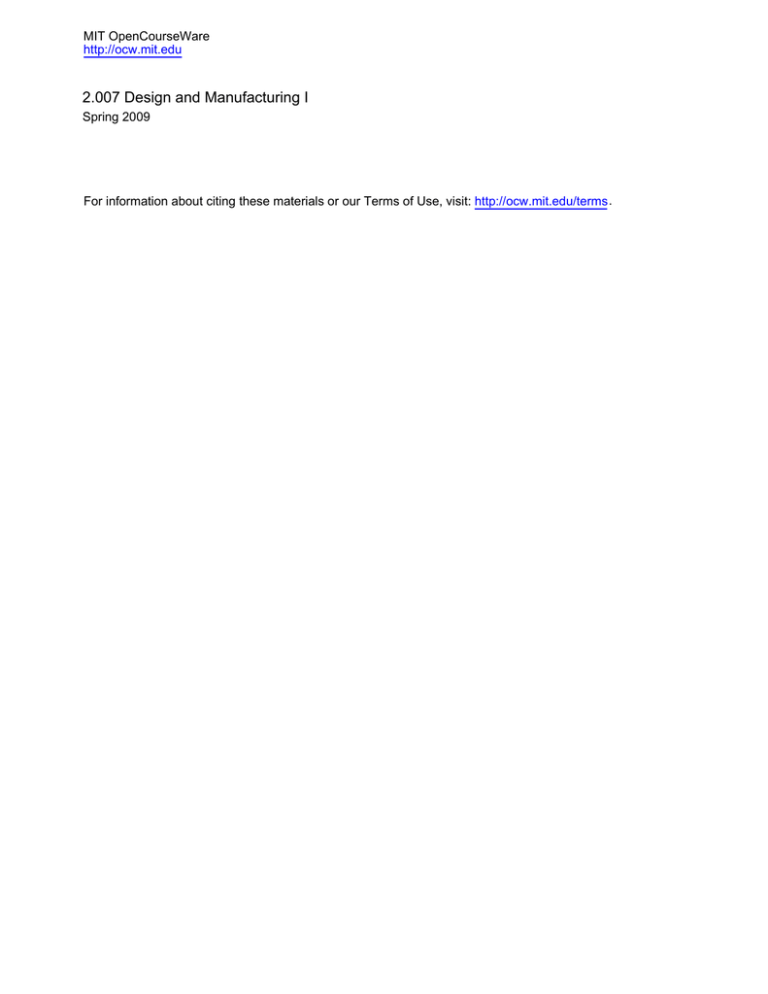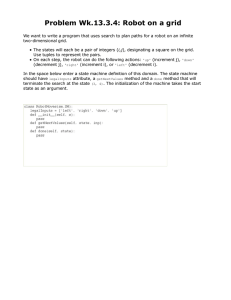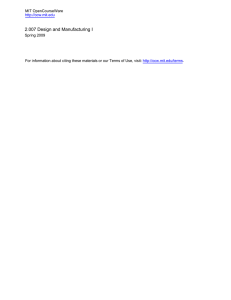Document 13664475
advertisement

MIT OpenCourseWare http://ocw.mit.edu 2.007 Design and Manufacturing I Spring 2009 For information about citing these materials or our Terms of Use, visit: http://ocw.mit.edu/terms. Some thoughts on notebooks and Milestone One What’s the role of milestones? The dictionary defines a milestone as “an action or event marking a significant change or stage in development. Milestones in 2.007 don’t depart much from this definition. They are markers of your design process—of you and your robot’s journey over the course of the semester. They are designed to ensure that you are making consistent and adequate progress from week to week and should be considered progress reports that organize and present the outcome of the work preceding them. This preceding work will take many forms: quick sketches, lists, storyboards, experiments, calculations, photos, etc. This work will inevitably vary from student to student and from week to week. The bulk of the work in your notebook may actually end up being, not the milestones, but the work between the milestones. The milestone is a clear, succinct and well-structured description of the work and the design process that led up to it. So…what should this design work look like? The work can take many forms. Indeed, part of your role as a designer will often be to determine what work best advances your design efforts. You may end up designing, not just your robot, but your own design process. That being said, let me offer some thoughts on what I’ve seen in your notebooks. Play Play is open and unconstrained exploration. In the case of the kit, I would expect to see evidence of your thinking about the various components and imaginative thinking about what you might do with them. Were there any parts that you thought had special promise? Any that you could already imagine uses for? One question I’ve already asked a few of you is “What would you do if I asked you to play with a kit of Legos?” It could be useful to document the quantity, dimensions and color of each of the pieces but would you stop with that? Your play would include an effort to see how the parts interact with each other and thoughts on things you might be able to do with various combinations of parts. Your exploration of the 2.007 kit should include evidence of this type of thinking. Other things you could explore and “play with” are the contest table and the scoring equation. When playing with the table you could stimulate your creative process via sketches, actually physically playing with the table, manipulating a CAD model of the table…the list goes on. To play with the scoring equation, you could use Excel or just a pen and paper to examine all of the possible scoring combinations. Explore Interactions Having played with the kit, the table and the scoring equation separately, you could then start to think about how they might interact. How do the dimensions of the kit parts impact how you think about the picking up bales? Fitting inside the starting box? Grasping the rope? How does the size of the table and the time limit interact with scoring? How long do you think it would take to achieve the various scores? Can you 2.007 Spring 2009 L. Neeley generate time estimates for potential robot maneuvers? How fast must your robot be? How slow can it be? Go for QUANTITY! When generating, the initial goal is to generate LOTS of information, insights and ideas. Go for quantity. If you’re imagining strategies, push yourself to come up with 10, 25 or even 50 different (basic) ideas. Let the creative juices flow. Defer judgment and criticism. Once you have lots of ideas to play with, review them, organize them and then you can move on to selection. What vs. How In generating ideas, you must strive to distinguish between What you want to do and How you want to do it. In generating potential strategies for the contest, some of you began imagining the design of graspers and different storage mechanisms for your robot. This is fine, but it shouldn’t be confused with the actual strategy itself. The strategy is what you want to do. The mechanisms are the means by which you’ll achieve what you want to do. You can imagine that there are many different ways that you might achieve any particular strategic goal. For example, if your goal is to stack cubes, you could generate dozens of different designs for a stacker robot. Generally speaking, you should first determine the what. Then you should determine the how. I say generally because these stages will not always be completely distinct in your design process but you should always strive to be aware of this distinction. Concept Selection Some of you had only three concepts in your notebook. It wasn’t clear how you settled on these three to develop further. I know that you used some process, but you need to externalize it. This benefits not only someone who reviews your notebook but also helps and forces you to be explicit about your selection process and honest with yourself. Consider using a Pugh chart as a tool to structure your selection process. Ultimately, you can make any selection you want. It is your process, but you should show and document your selection. Updating & Refining You will be learning new things throughout your design process. Sometimes this will be a result of explicit experimentation, prototyping or research. Other times the learning will be the collateral result of other design activities. Whichever the case, you should review your plans and update your thinking based upon new learning. For example, some of you changed your strategies based upon observations of how your simple car interacted with the table. Others of you had estimated the driving speed of a robot built using the continuous rotation servos. How did the actual speed of your robot compare? How did this speed impact your strategy? Your anticipated score? References As has been said in lecture and reiterated in section, we encourage you to explore broadly when designing, as long as you document your sources. In coming up with ideas, a few of you looked at past 2.007 robots and included pictures in your notebooks. Other sources of 2.007 Spring 2009 L. Neeley information and inspiration included searching the web, the library or discussions with your peers. Ideas come from EVERYWHERE! As with every part of your design process, be creative in your efforts. As a final note, I’ll offer that there are many great references not just for design but also for understanding the design process. One such reference is Alex Slocum’s book, which is available on Stellar. In particular, I encourage you to look at what he calls FRDPARRC. It describes a generally helpful way of thinking about design problems by considering the following six factors: Functional Requirements, Design Parameters, Analysis, Reference, Risk and Countermeasures. 2.007 Spring 2009 L. Neeley





